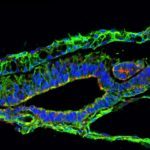Link to Pubmed [PMID] – 15177035
Dev. Cell 2004 Jun;6(6):875-82
The study of the morphogenetic cell movements underlying myotome formation in the chick embryo has led to the emergence of highly controversial models. Here we report a real-time cell lineage analysis of myotome development using electroporation of a GFP reporter in newly formed chick somites. Confocal analysis of cell movements demonstrates that myotome formation involves two sequential steps. In a first phase, incremental myotome growth results from a contribution of myocytes derived solely from the medial border of the dermomyotome. In a second phase, myocytes are produced from all four borders of the dermomyotome. The relative distribution of myocytes demonstrates that the medial and the lateral borders of the somite generate exclusively epaxial and hypaxial muscles. This analysis also identified five myotomal regions, characterized by the origin of the myocytes that constitute them. Together, our results provide a comprehensive model describing the morphogenesis of the early myotome in higher vertebrates.

